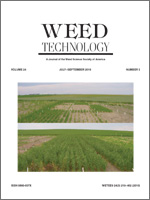Postemergence herbicides to control grass weeds in grain sorghum are limited. Acetolactate synthase (ALS) –inhibiting herbicides are very effective at controlling many grass species in many crops; unfortunately, use of ALS-inhibiting herbicides is not an option in conventional grain sorghum because of its susceptibility to these herbicides. With the development of ALS-resistant grain sorghum, several POST ALS-inhibiting herbicides can be used to control weeds in grain sorghum. Field experiments were conducted in 2007 and 2008 to evaluate the efficacy of tank mixtures of nicosulfuron rimsulfuron applied alone or in combination with bromoxynil, carfentrazone–ethyl, halosulfuron dicamba, prosulfuron, 2,4-D, or metsulfuron methyl 2,4-D. In addition, these treatments were applied with and without atrazine. Nicosulfuron rimsulfuron controlled barnyardgrass, green foxtail, and giant foxtail 99, 86, and 91% 6 wk after treatment (WAT), respectively. A decrease in annual grass control was observed when nicosulfuron rimsulfuron was tank mixed with some broadleaf herbicides, although the differences were not always significant. In addition, nicosulfuron rimsulfuron controlled velvetleaf and ivyleaf moringglory 64 and 78% 6 WAT, respectively. Control of velvetleaf was improved when nicosulfuron rimsulfuron was tank mixed with all broadleaf herbicides included in this study with the exception of atrazine, bromoxynil, and prosulfuron atrazine. Control of ivyleaf morningglory was improved when nicosulfuron rimsulfuron was tank mixed with all of the herbicides included in this study with the exception of metsulfuron methyl 2,4-D. Weed populations and biomass were lower when nicosulfuron rimsulfuron were applied with various broadleaf herbicides than when it was applied alone. Grain sorghum yield was greater in all herbicide treatments than in the weedy check, with the highest grain yield from nicosulfuron rimsulfuron prosulfuron. This research showed that postemergence application of nicosulfuron rimsulfuron effectively controls grass weeds, including barnyardgrass, green foxtail, and giant foxtail. The research also showed that velvetleaf and ivyleaf morningglory control was more effective when nicosulfuron rimsulfuron were applied with other broadleaf herbicides.
Nomenclature: Atrazine; bromoxynil; carfentrazone–ethyl; dicamba; halosulfuron; mesotrione; metsulfuron methyl; nicosulfuron; rimsulfuron; prosulfuron; S-metolachlor; 2,4-D; barnyardgrass, Echinochloa crus-galli (L.) P. Beauv.; giant foxtail, Setaria faberi Herrm.; grain sorghum, Sorghum bicolor (L.) Moench.; green foxtail, Setaria virdis (L.) Beauv.; ivyleaf morningglory, Ipomoea hederacea (L.) Jacq.; velvetleaf, Abutilon theophrasti Medicus.





